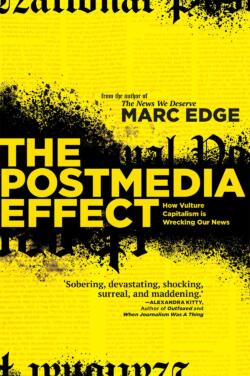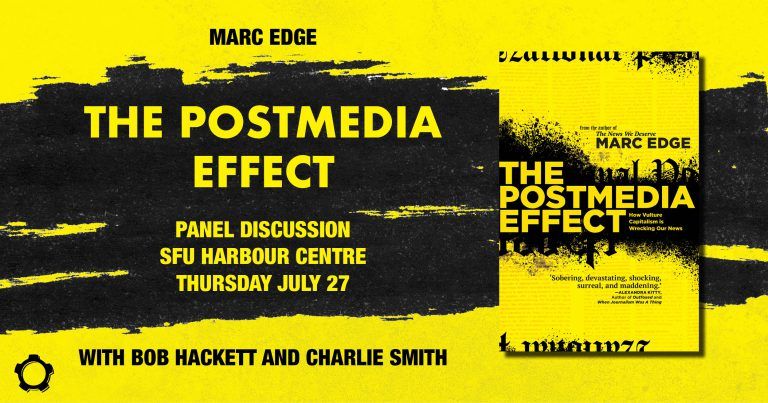1903 Corporate media bad guys
The Postmedia Effect: How Vulture Capitalism is Wrecking Our News
by Marc Edge
Vancouver: New Star Books, 2023
$25.00 / 9781554201976
Reviewed by Ron Verzuh
*
 Notice how your local newspaper isn’t quite what it used to be? Maybe there are fewer local news stories reported. Maybe it’s no longer serving as a watchdog at city hall. School board meetings aren’t covered anymore? Housing and health care public meetings get missed. Well, there’s a reason for the deteriorating quality of your newspaper and The Postmedia Effect tells you what it is.
Notice how your local newspaper isn’t quite what it used to be? Maybe there are fewer local news stories reported. Maybe it’s no longer serving as a watchdog at city hall. School board meetings aren’t covered anymore? Housing and health care public meetings get missed. Well, there’s a reason for the deteriorating quality of your newspaper and The Postmedia Effect tells you what it is.
Relentless, dogged, and thorough are words that accurately describe investigative writer Marc Edge’s book on the corporate dismantling of the Canadian news media wherein all the culprits are exposed. A chief culprit in this tale of disappearing newspapers is Paul Godfrey, the rich and powerful Postmedia conglomerate’s main man. And, as Edge documents, he got rich by undermining the quality of Canada’s newspapers.
If you don’t believe our country’s print media are under constant attack by big money interests and hedge funds in the United States, turn any page of Edge’s well-researched and unstoppable probe and you will learn differently. As the author of several other books about media and as media columnist for Canadian Dimension magazine, he is well qualified to dig out the dirt on the corporate vultures. He knows how to follow the money trail with exhausting efficiency.

For a succinct summary of what Godfrey has done, Edge turns to Communications Workers of Canada union representative Martin O’Hanlon. “Godfrey has all but destroyed a once-venerable newspaper chain,” he says. “And it’s not because newspapers aren’t making money – they are. It’s because he needs to feed profits to predatory hedge funds lenders who keep him in their pocket with these big bonuses.”
If you are not aware that your local daily newspaper could sink into the profit-gobbling maw that is the news business today, get ready for a reality check (both the Vancouver Sun and Province are part of the Postmedia stable). As news-gathering deteriorates with the layoff of hundreds of journalists, Edge reveals a corporate culture that could care less. Show them the money and they’ll show news producers the swinging door to the unemployment lines.
Of course, Godfrey was not the first to strip bare Canada’s newspapers and pocket the bonuses. Sharing some history, Edge recounts the rise of media-mogul Roy Thomson. His newspaper chain “became notorious for penny pinching, paying low salaries, [and] issuing pencils individually.” Following in Lord Thomson’s footsteps was the peerless Conrad Black. Another profit-sucking predator, Black cut newsroom staff and imposed his neo-conservative political agenda on the journalists that remained. His flagship daily, Toronto’s conservative National Post, hired Godfrey as its CEO in 2009.

Other newspaper chains followed the Godfrey-Black formula. The Asper family in Winnipeg and the Irvings in New Brunswick are both exposed as profit-gougers whose newsrooms were governed from the board room. Subsequently, dailies and weeklies were more than ever filled with advertising flyers. News stories for all the papers in the chain were produced cookie-cutter fashion in a centralized news production house. And let’s not forget the greatest predator of them all, Rupert Murdoch, the Australian newspaper magnate who gave us Fox News.
For Edge, what’s at stake with all the buying and selling of newspapers is the eventual demise of a once-respected institution. “The Postmedia Effect took down not only Canada’s largest newspaper chain, but then its second-largest chain Sun Media in 2014,” he writes, “and it threatens to consume the entire industry.”
Edge explores government bailouts in depth as a way to save papers. The union Unifor supported the idea through its then president Jerry Dias. National Post columnist Andrew Coyne was vehemently against it. “Of all the voices that might argue for government support of newspapers,” he stated, “the very last should be those of the newspapers themselves.” Coyne, now a columnist for the Globe and Mail, served as the voice of integrity throughout Edge’s account.
“Whoring out” the Sun and Province editorial pages was another money maker for Postmedia, but it got caught when staff rebelled against it. When a series of paid-for editorials began to appear, it became clear that the University of BC had cut a deal with Postmedia to have advertising pose as editorial content. The Sun took a further hit when its staff balked at the use of racist comments. Journalists, particularly ethnic ones, “had watched for too long as the Sun and Province peddled racist drivel on their editorial pages,” Edge reported.

To support his argument, Edge cites historic social thinkers such as American journalist Walter Lippman, historian Harold Innis and Marshall McLuhan, the philosopher who explained that the “medium is the message.” “Throughout history, from the hieroglyphics engraved on stone tablets in ancient Egypt to the scrolls of papyrus in ancient Rome,” Edge writes, “control of a society’s dominant medium meant control of society itself.” Or, as Italian Marxist Antonio Gramsci put it, control of the media is critical to “the organization of consent.”

He also revisits numerous studies focused on media concentration, convergence and foreign hedge-fund financing, the blending of information technologies, computer networks, and content into print and broadcast monopolies. Further, he has unearthed the various commissions and think tanks studying such activity. Perhaps the best known of these is the 1970 special Senate committee report on mass media concentration headed by Senator Keith Davey. His assignment was to study media monopolies. He found that media corporations were sitting on “one of the hottest scoops . . .their own balance sheets,” showing gluttonous profiteering.
The impact of the hedge-fund money grab is the rapid disintegration of quality news coverage. While promising better community news service, the opposite is taking place. Readers who once saw their local paper as part of the social well-being of their town, now turn their heads to online news services much of it manufactured elsewhere.
Edge’s book is not simply an exposé, it is a blistering indictment using facts not polemics. As Alexandra Kitty writes in her foreword to the book, “Fasten your seatbelt as you go down the twisted rabbit hole known as Postmedia. It will be a wild and eye-opening ride.” I couldn’t agree more.
*

Ron Verzuh is a writer, historian and documentary filmmaker. His latest book is Printer’s Devils, a study of some of BC’s early 20th century weekly newspapers. [Editor’s note: Ron Verzuh has recently reviewed books by Bobbi Hunter (editor), BC Hydro Power Pioneers with Kerry Gold, J. Edward Chamberlin, Glen A. Mofford, Derek Hayes, Keith G. Powell, Derryll White & Erin Knutson for The British Columbia Review, and he has contributed an essay on trade unionist Harvey Murphy. Ron lives in Victoria.
*
The British Columbia Review
Interim Editors, 2023-24: Trevor Marc Hughes (non-fiction), Brett Josef Grubisic (fiction)
Publisher: Richard Mackie
Formerly The Ormsby Review, The British Columbia Review is an on-line book review and journal service for BC writers and readers. The Advisory Board now consists of Jean Barman, Wade Davis, Robin Fisher, Barry Gough, Hugh Johnston, Kathy Mezei, Patricia Roy, Maria Tippett, and Graeme Wynn. Provincial Government Patron (since September 2018): Creative BC. Honorary Patron: Yosef Wosk. Scholarly Patron: SFU Graduate Liberal Studies. The British Columbia Review was founded in 2016 by Richard Mackie and Alan Twigg.
“Only connect.” – E.M. Forster
8 comments on “1903 Corporate media bad guys”
The Columbia Journal would like to reprint Ron’s review of “The Postmedia Effect” in our September edition. We are asking for your permission to do that.